The 2022 Nobel prize in physics was awarded to Alain Aspect, John Clauser and Anton Zeilinger “for experiments with entangled photons, establishing the violation of Bell inequalities and pioneering quantum information science“. Hamish Johnston gave a brief account in Physics World on October 4th. He said the three laureates performed the key experiments that established the quantum property of entanglement. That’s quantum entanglement, which is often described as spooky action at a distance. The idea is that you produce two photons from one event, and when you measure the spin of one photon, it somehow instantly affects the spin of the other, even if it’s miles away.
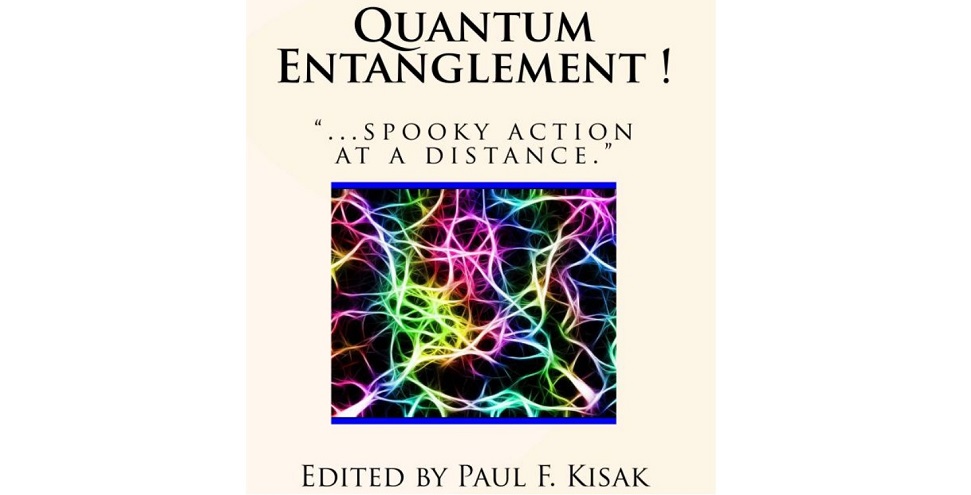 Cover image from Quantum Entanglement! Spooky action at a distance edited by Paul Kisak
Cover image from Quantum Entanglement! Spooky action at a distance edited by Paul Kisak
Johnston gave a potted history, saying “the first experiment was done in 1972 by Clauser, who measured the correlations between the polarizations of pairs of photons created in an atomic transition. He showed that Bell’s inequality was violated – which meant that the photon pairs were entangled”. Johnston went on to say there were shortcomings or loopholes in Clauser’s experiment, and that in 1982, Alain Aspect and colleagues improved matters with a two-channel detection scheme and varying the orientation of the polarizing filters. Then Johnston said another loophole was closed in 1998 by Anton Zeilinger and colleagues, who used random number generators to set the directions of the photon measurements at the last instant. Johnston also said this: “As well as confirming a fundamental prediction of quantum mechanics, the three experiments laid the groundwork for the development of modern quantum technologies”. And this: “entanglement plays an important role in quantum computers, which in principle could outperform conventional computers at some tasks”.
The theory was incomplete
For further background, check out the Nobel Prize website where you can find the award ceremony speech by Professor Mats Larsson. He said in 1935 Einstein challenged quantum mechanics and argued that the theory was incomplete, whilst Bohr argued that it was complete, and Schrödinger said entanglement between particles with a common past was “the characteristic trait”. Larsson also said in 1964 John Stewart Bell came up with Bell’s inequality, which pointed to a way to experimentally resolve the conflict between Einstein and Bohr. Larsson went on to say Clauser’s 1972 experiment suggested Bohr was more correct than Einstein. Follow the link in the Nobel press release page to the scientific background document for further details. Alternatively check out the online transcript of the Nobel press conference, where Professor Thors Hans Hansson effectively said Einstein said God does not play dice. If I might add, this was in letter to Max Born, where Einstein said: “Quantum mechanics is very worthy of regard. But an inner voice tells me that this is not yet the right track. The theory yields much, but it hardly brings us closer to the Old One’s secrets. I, in any case, am convinced that He does not play dice”. Einstein was saying the probabilistic nature of quantum mechanics was not enough. Hansson went on to say Niels Bohr and Erwin Schrödinger thought that quantum mechanics was OK as it was, and this position was put very clearly in the paper The Present Situation in Quantum Mechanics. That’s odd, because Schrödinger didn’t think that, on page 8 he used his cat-in-a-box scenario to show how ridiculous things were, and he used the word repugnant in a different paper. Something else that’s odd was that Hansson called him Edwin as opposed to Erwin. But moving on, Hansson went on to say the modern version of the experiment is where a source “emits pairs of particles, entangled pairs, Bell pairs”. He said one particle reaches Alice and another reaches Bob, who each make a measurement of particle spin:
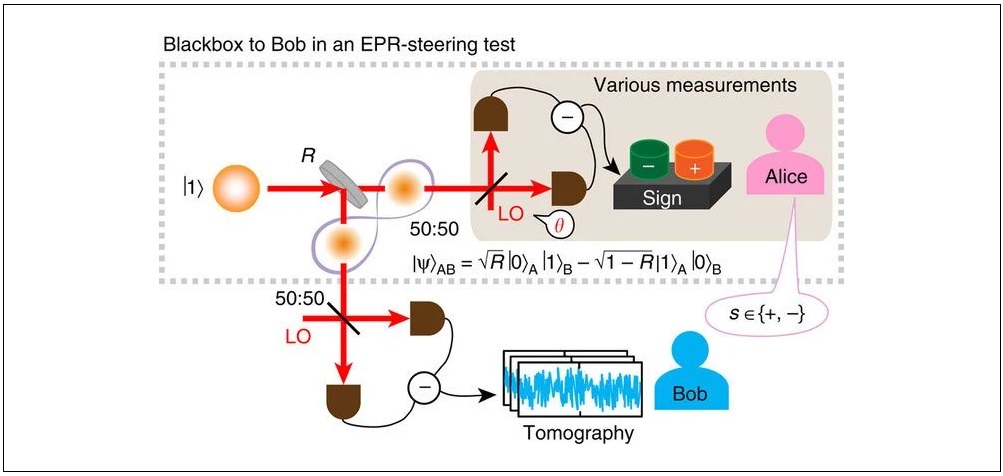 Image from Experimental proof of nonlocal wavefunction collapse for a single particle using homodyne measurements
Image from Experimental proof of nonlocal wavefunction collapse for a single particle using homodyne measurements
Hansson also said “in quantum mechanics, this spin can only take two values, plus or minus”. He told us that when the experiment is repeated multiple times, Alice will record a sequence of pluses and minuses, as will Bob. But “the strange thing is that when they compare the measurements, every time Alice sees a plus, Bob will see a minus and vice versa”. Hansson said this was very strange. He used a playing card analogy, where the dealer shuffled the pack and dealt them out to two players, who always turned up one plus and one minus or vice versa. Hansson said this posed a question as to whether there were some hidden variables that we were not aware of. He went on to say that in 1964 John Bell “made an amazing theoretical discovery”. Hansson was referring to Bell’s theorem. He said Bell could show that “the predictions of quantum mechanics couldn’t be reproduced by any kind of theory based on hidden variables, however complicated”.
A very very strange property of quantum mechanics
Later on in the transcript you can read Hansson being interviewed by journalist Sharon Jåma. There’s a YouTube video on the Nobel Prize website. Hansson said this year’s prize was for work that has made clear what quantum mechanics really means. He talked about three billiard balls, and said you can look at one of the balls and say it’s red or yellow or white, and that’s nothing to do with the others balls. He then said in quantum mechanics it works differently. You can have quantum mechanical states which are called entangled, and then you cannot just look at this one and say it’s yellow without somehow affecting what is happening to the other one. He also said it’s a very very strange property of quantum mechanics, and this year’s prize helps us understand more about the nature of this peculiar feature. He also talked about applications, referring to quantum cryptography and quantum computers.
The EPR paper
I’d say this is the “mainstream” view of quantum entanglement, which features spooky action at a distance. But is it the correct view? To investigate that we have to start with the EPR paper. It was published in Physical Review on May 13th 1935. The actual title was Can Quantum-Mechanical Description of Physical Reality be Considered Complete? It’s fairly short at four pages long:

It says for a complete theory, every element of physical reality must have a counterpart in that theory. It then talks about a particle according to quantum mechanics, and says “the fundamental concept of the theory is the concept of state, which is supposed to be completely characterized by the wave function ψ”. It also says “the usual conclusion from this in quantum mechanics is that when the momentum of a particle is known, its coordinate has no physical reality”. This is complementarity, a concept invented by Niels Bohr. It wasn’t just some wave-nature-of-matter issue of measuring subatomic waves with devices made up of other subatomic waves. This wasn’t just Heisenberg’s uncertainty principle, which is inherent in the properties of all wave-like systems. This was Bohr saying a particle has a real momentum or a real position, but not both. Measure the momentum and there is no reality to the position, and vice versa. The EPR paper then says “it is shown in quantum mechanics that, if the operators corresponding to two physical quantities, say A and B, do not commute, that is, if AB≠BA, then the precise knowledge of one of them precludes such a knowledge of the other”.
Two different realities
The paper then talks about two systems which interact for a time, whereafter the state of the combined system is described by a combined wave function. However the state of either one of the two systems can only be determined via further measurements, “by a process known as the reduction of the wave packet”. That’s wave function collapse. What we have here is something like two photons produced by some event, which then move apart in opposite directions. Measure the momentum of the first photon, and the second photon is left in the state ψk(x2). Measure the position of the first photon, and the second photon is left in a different state φk(x2). However nothing can travel faster than light, so there’s no way to affect the second photon, and it can’t have two different states, because that would mean there were two different realities. Hence “we are forced to conclude that the quantum-mechanical description of physical reality given by wave functions is not complete”. I thought it was a fairly clear paper, and presented a good argument. Particularly since I think the idea of two or more different realities is many-worlds moonshine:
 Public domain image by Christian Schirm, see Wikipedia commons and the Wikipedia Many-worlds interpretation article
Public domain image by Christian Schirm, see Wikipedia commons and the Wikipedia Many-worlds interpretation article
I also agreed with the premise, in that quantum mechanics doesn’t tell us what a photon is, how pair production works, or what the electron is. It says electron spin is an abstract thing via a spinning faster than light non-sequitur, despite the hard scientific evidence of the Einstein-de Haas effect and Larmor precession in a magnetic field. Quantum mechanics clings to a probabilistic point-particle electron despite all the wave evidence and papers of the 1920s, and hence in the 1930s was crippled by the problem of infinities. Even though the Nobel Prize in 1937 was awarded to Clinton Joseph Davisson and George Paget Thomson for experimental confirmation of the wave nature of the electron. Only a blind man would argue that quantum mechanics was complete.
All rational demands of completeness
Niels Bohr, who by the way was awarded a Nobel prize in a 1922, replied via an 8-page paper of the same name which appeared in Physical Review on 15th October 1935. The abstract says the EPR paper contains an ambiguity, says complementarity is explained, and says “the quantum-mechanical description of physical phenomena would seem to fulfill, within its scope, all rational demands of completeness”. I thought that was rather barbed. Bohr then started with a summary of the EPR paper, and then referred to “the necessity of a final renunciation of the classical ideal of causality” and “a radical revision of our attitude towards the problem of physical reality”. But then instead of actually addressing the EPR paper, he talked about a particle passing through a slit in a diaphragm, and “the diffraction by the slit of the plane wave giving the symbolic representation of its state”. He referred to electron diffraction and the “position of the spot produced by the particle on the photographic plate”. Then he talked about a measurement that allows us to conclude which slit the particle passed through, will result in “the total wiping out of any interference effect”.
The double slit experiment
This is the double slit experiment. I don’t see any mystery to that. When you detect the electron at the screen, you perform something akin to an optical Fourier transform on it, so you “focus” it into something pointlike. So you see a dot on the screen. Then when you detect the electron at one of the slits, you perform something akin to an optical Fourier transform on it, so you “focus” it into something pointlike. So it goes through that slit only. So the interference patterns disappears.
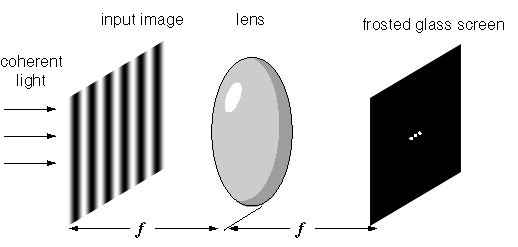 Image from Steven Lehar’s intuitive explanation of Fourier theory: a simple lens can perform a Fourier transform in real time
Image from Steven Lehar’s intuitive explanation of Fourier theory: a simple lens can perform a Fourier transform in real time
I’m not kidding about this. Note that Art Hobson gave a similar explanation in his 2013 paper There are no particles, there are only fields. He says a large object such as a balloon can interact quite locally with another object such as a tiny needle, and says the detection localizes or “collapses” the quantum. Also note that the Wikipedia wave function article says the domain is not unique, and “it may be taken to be a function of all the position coordinates of the particles over position space, or the momenta of all the particles over momentum space; the two are related by a Fourier transform”. Anyway, after talking at length about the double-slit experiment, Bohr said the EPR scenario “does not actually involve any greater intricacies than the simple examples discussed above”. I could see no justification for this claim. He then threw in “an influence on the very conditions which define the possible types of predictions regarding the future behavior of the system”. This was in italics, and looks like a rather handwavy claim that spooky action at a distance could indeed occur. Then he talked at length about energy and time, then he talked about general relativity, saying we must renounce the customary separation of space and time, and then talked about “a radical revision of our attitude as regards physical reality”. I have to say I found Bohr’s paper to be rambling, off-topic, and totally unconvincing.
Schrödinger’s 1935 paper
I didn’t feel the same about Erwin Schrödinger’s 1935 paper Discussion of Probability Relations between Separated Systems. It was published on 28 October 1935 in the Mathematical Proceedings of the Cambridge Philosophical Society. Note that it was communicated by Max Born:
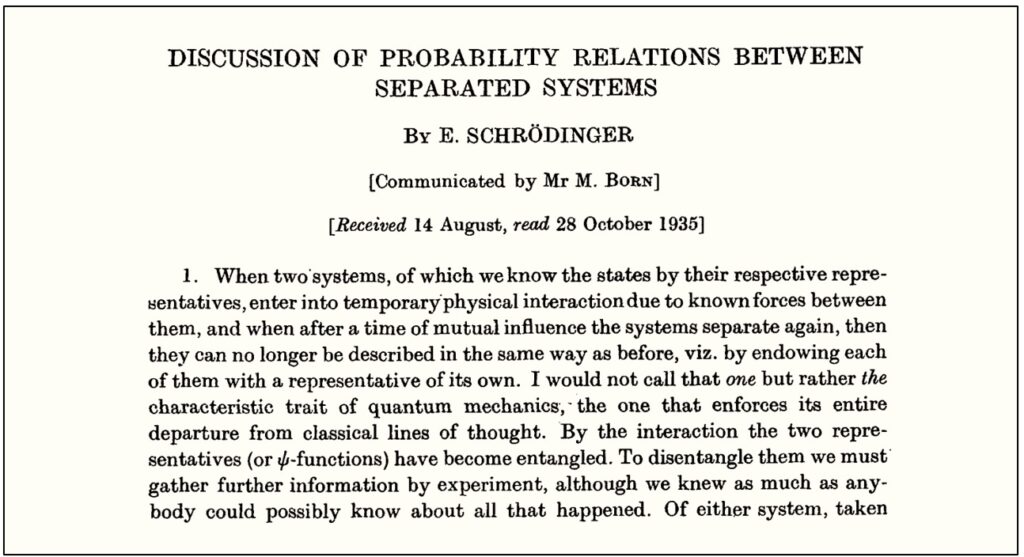
It’s a heavily mathematical paper, and it would take me a month to give a half decent account of it, so I will have to cut to the chase. Schrödinger said after two systems interact, they have to be described by a single “representative” or wave function, and that this was “the characteristic trait of quantum mechanics, the one that enforces its entire departure from classical lines of thought”. He said this was because “the two representatives (or ψ-functions) have become entangled”, and “to disentangle them we must gather further information by experiment”. It might sound as if Schrödinger is siding with Bohr, but he isn’t. On the fifth page (journal page 559) he says this: “But of course every one of the four observations in question, when actually performed, disentangles the systems, furnishing each of them with an independent representative of its own”. So if you measure the polarization of one photon, you don’t have a pair of entangled photons any more. Schrödinger also wrote a paper in 1936 called Probability relations between separated systems. Again it’s a heavily mathematical, but again to cut to the chase, on the sixth page (451) he says “the whole system (comprising in our case both systems) has to be small enough to be able to neglect the time that light takes to travel across the system”. He uses the phrase unretarded actio in distans. He’s saying instantaneous action at a distance is not on. On the final page he says it’s “repugnant to some physicists including the author”. As to why the Nobel committee thought Schrödinger was on Bohr’s side I do not know. Perhaps they were misinformed.
Schrödinger’s cat
To find out more take a look at The Einstein-Podolsky-Rosen Argument in Quantum Theory by Arthur Fine. He tells us that Schrödinger said “this assumption arises from the standpoint of the savage, who believes that he can harm his enemy by piercing the enemy’s image with a needle”. That was in a letter to Edward Teller dated 14th June 1935. Fine provides some other history: like the EPR paper was written by Podolsky, and Einstein didn’t check it, and then told Schrödinger that he was not pleased with the result because it obscured his central concerns. Fine also gives some Solvay history where Einstein pondered localizing the particle during propagation, and tells us about Einstein’s letter to Schrödinger with the gunpowder example that morphed into Schrödinger’s cat. As I’ve said before, Einstein and Schrödinger were “realists” who worked together to oppose the “mystics” of the Copenhagen School. Schrödinger’s cat was also intended to show the incompleteness of quantum mechanics. Sadly it has been hijacked by the mystics to promote quantum weirdness. Schrödinger’s cat is described on page 8 of Schrödinger’s 1935 paper The Present Situation in Quantum Mechanics.
Hidden variables
I’d say the next development was David Bohm’s two-part paper in 1952. It was A Suggested Interpretation of the Quantum Theory in Terms of “Hidden” Variables I and II. Bohm was talking about hidden variables, which are in essence things we don’t know. That’s good to hear. But then there’s this on journal page 170: “we have electively been led to regard the wave function of an individual electron as a mathematical representation of an objectively real field. This field exerts a force on the particle in a way that is analogous to, but not identical with, the way in which an electro-magnetic field exerts a force on a charge”. It’s good to hear him talking about wave function as something real, but not good to hear him talking about a particle as something point-like. On journal page 173 he talked about the double-slit experiment performed with electrons, and said “in the usual interpretation of the quantum theory, the origin of this interference pattern is very difficult to understand”. Only it’s easy to understand if you think of detection as something that performs an optical Fourier transform. On journal page 186 he refers to the EPR experiment, saying there’s no conceptual model showing how the second particle is “able to obtain either an uncontrollable disturbance of its position or an uncontrollable disturbance of its momentum depending on what kind of measurement the observer decided to carry out on the first particle”. That’s fair enough, as is his comment that “Bohr’s point of view was that no such model should be sought”. We do physics to understand the world, not to wallow in mysticism. However what’s not so good is this: “Thus, the ‘quantum-mechanical’ forces may be said to transmit uncontrollable disturbances instantaneously from one particle to another through the medium of the ψ-field”. That’s instantaneous spooky action at a distance. That’s definitely not good. Bohm went on to claim that there’s “no contradictions with relativity” because “no signal can be carried in this way”, but I thought it was a cop-out. I dislike it. Ditto re his reference to de Broglie’s pilot wave theory in appendix B. It’s now known as De Broglie–Bohm theory. I dislike that because it’s like saying a hurricane is the eye of the storm. All in all I found this pair of papers to be tedious and rambling, and I disliked the use of the royal “we”.
The EPRB experiment
Also see the Wikipedia article on the Einstein–Podolsky–Rosen paradox where you can read about Bohm’s variant. It’s known as the EPRB experiment, and it concerns spin as opposed to position and momentum. Bohm first talked about it in his 646-page book Quantum Theory, published by Prentice-Hall. Apologies, I can’t find a copy online, but Wikipedia refers to section 19. Arthur Fine’s article refers to sections 22.15–22.18, so perhaps they’re referring to different editions. But regardless, there’s a 1957 paper co-authored with Yakir Aharonov which gives details. It’s Discussion of Experimental Proof for the Paradox of Einstein, Rosen, and Podolsky. It talks about “a rather strange kind of correlation in the properties of distant things”, which is the spooky action at a distance. It also talks about a spin 0 molecule consisting of two spin ½ atoms A and B. The atoms separate, whereafter “any desired component of the spin of the first particle (A) is measured. Then, because the total spin is still zero, it can immediately be concluded that the same component of the spin of the other particle (B) is opposite to that of A”. There’s nothing wrong with that. Or with using Stern-Gerlach magnets in an experiment:
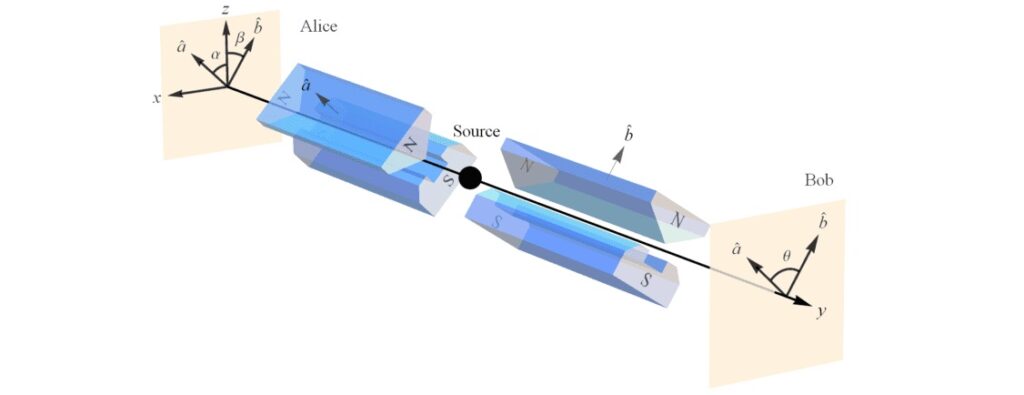 Image from Why the Quantum | A Response to Wheeler’s 1986 Paper | Physics Forums, caption: Alice and Bob making spin measurements in the xz plane on a pair of spin-entangled particles with their Stern-Gerlach (SG) magnets and detectors.
Image from Why the Quantum | A Response to Wheeler’s 1986 Paper | Physics Forums, caption: Alice and Bob making spin measurements in the xz plane on a pair of spin-entangled particles with their Stern-Gerlach (SG) magnets and detectors.
The paper says in essence that there are complexities when using atoms, and at present the only practical test is using correlated photons, such as those produced from electron-positron annihilation, and then seeing if the polarizations are perpendicular in every system of axes. I think that’s a bit of a leap, but the paper also talks about testing using the spin of electrons, which I think isn’t. Hence I also think it’s reasonable for the Bohm’s variant section of the Wikipedia Einstein–Podolsky–Rosen paradox article to talk about electrons and positrons rather than atoms. But the paper also says in quantum theory only one component of the spin of each spin ½ particle can have a definite value at a given time. It says “we are free to choose any direction as the one in which the spin of particle A (and therefore of particle B) will become definite”. And “if the x component is definite, then the y and z components are indeterminate”. That’s a claim based upon ignorance of electron spin. The paper also says “in any single case, the total angular momentum will not be conserved”. Surely that’s a massive red flag?
This was Max Born, the author of the probabilistic Born rule, talking about a spin ½ particle with a real spin
It is crystal clear that Bohm never read On the quantization of the new field theory II written in 1935 by Max Born and Leopold Infeld. On page 17 (159) they talked about spin ½ particles and said this: “the rest-mass occurring in our theory is not, as in Dirac’s, an absolute constant of the system but the total internal energy, depending on rotation and internal motion of the parts of the system. An external field will influence not only the translational motion, but also these internal motions”. This was Max Born, the author of the probabilistic Born rule, talking about a spin ½ particle with a real spin. It isn’t spinning like a planet, it’s a wave in a closed path with two orthogonal rotations, like the 720° spinor which is likened to the Möbius strip. So measuring the spin in the x direction just doesn’t cut it. Nor does saying the “y and z components are indeterminate”. Conservation of angular momentum says they are not indeterminate. Conservation of angular momentum is why the spins are opposite. How can anybody say an experiment demonstrates spooky action at a distance when they just don’t know what the electron is? When they just don’t know what they’re dealing with? They can’t. The demonstration of “a rather strange kind of correlation in the properties of distant things” is a straw-man argument, just like the a spinning faster than light non-sequitur. Especially when they also say “in any single case, the total angular momentum will not be conserved”. This was not good science. This was bad science, and it was going to get worse. A whole lot worse.
 Photon and electron depiction by me
Photon and electron depiction by me
Good to see a number on the title again!
Can’t wait for the next part, though I felt this post was rather light on conclusions.
I didn’t really take away what entanglement is for you.
Happy new year!
Happy new year Leon. I started writing this and realised it would end up being way too long, so I’ve had to split it. So yes, it’s rather light on conclusions as yet, but do note my last line. Also, you might like to take a look at the article I wrote on quantum computing.
Note: in writing part II, I realised I’d missed something out of the chronological sequence. Hence I added a paragraph on Bohm’s hidden variables papers, which came before his paper with Aharonov. Because of this I then removed one image near the end and replaced another.
So a condensed version of this years Dyn-O-Myte Award in physics is :
A. The winners belive in the SM.
B. Their test results are thus bogus.
C.They only win because the subject is too complicated for the committees to properly understand; and the entire process to corrupt/broken.
D. And all off this happens every single year because the basic tautology of quantum mechanics has been mostly wrong since 1929 and said tautology still controlled by an evil cabal of self-seving academics/journalists jackasses.
Most of this is considered common knowledge amongst most of your dedicated readers thanks to you John.
Keep up your exceptional historical documentation that provides validation for when,where,who,what,was,and why theoretical quantum physics gone wrong.
I think it’s something like this Greg:
A. The winners want to believe in quantum entanglement and the associated instantaneous spooky action at a distance.
B. They want their test results to confirm the above, and don’t want to think of other non-mystical explanations.
C. They only win because the Nobel committee don’t understand the physics, and because physics at large is in the doldrums, so said Nobel committee is scratching around for somebody to aware a prize to.
D. This sort of thing happens a lot because contemporary physics is wrong in a variety of areas, and because the culture in academia is one of propaganda, censorship, and dog-eat-dog dishonesty. Once invested in woo they will fight tooth and nail to prevent its exposure. Some elements of the media are not blame free either, Quanta magazine being a salient example. I have been giving some of my time to try to improve the situation. I hope it helps!
One last comment : I think Our Lady of the Fields St. Sabine is correct that everyone is ” Lost in Maths”. My simplistic take is the SM is “Ass Backwards” : too many predictions first, followed by convoluted/fabricated results secondly. Doesn’t the Scientific Method suggests observations firsts, hypothesis second ?
I think it’s even worse than you think, Greg. In the fullness of time I hope that people will come to see this.
Bohm’s result have a striking resemblance to experiments of beads being bounced on oil baths, called walkers (https://youtu.be/eg5MJQ-EfkY , at 16:35). These reproduce most if not all quantum experiments to date, thus they do represent a very good model.
I think my issue with the optical Fourier transform view is that it’s not clear to me how the electron looks like before the measurement. It can’t be just a photon in a loop of the dimensions of the electron radius, otherwise it would not be able to go through both slits due to its size. Do free electrons “disperse” in space? Then how do they keep their electron nature?
Leon: people will tell you an electron is some kind of billiard ball thing at the centre of its electromagnetic field. That’s the wrong way of looking at it. The electron is that field. Think of a hurricane. A hurricane isn’t some thing in the middle of a whole mess of wind. The hurricane is that wind. The thing in the middle isn’t the hurricane. There is no wind there. That’s just the ” rel=”nofollow ugc”>eye of the storm. See the last image in my article above? The thing on the right is a simplified depiction of the electron. The round black thing in the middle of that isn’t the electron. Yes it has a small radius, but it’s like the eye of the storm. It isn’t the radius of the electron any more than some 5-mile eye was the radius of hurricane Katrina. The electron is the surrounding field, which as far as I can tell is akin to the frame-dragging of the gravitomagnetic field. But dynamical, a wave going round and round that looks like a standing field, but isn’t really standing. Lots of physicists wrote papers saying this sort of thing in the 1920s and 1930s but I don’t think Bohm read any of them.
” rel=”nofollow ugc”>eye of the storm. See the last image in my article above? The thing on the right is a simplified depiction of the electron. The round black thing in the middle of that isn’t the electron. Yes it has a small radius, but it’s like the eye of the storm. It isn’t the radius of the electron any more than some 5-mile eye was the radius of hurricane Katrina. The electron is the surrounding field, which as far as I can tell is akin to the frame-dragging of the gravitomagnetic field. But dynamical, a wave going round and round that looks like a standing field, but isn’t really standing. Lots of physicists wrote papers saying this sort of thing in the 1920s and 1930s but I don’t think Bohm read any of them.
What if the electron doesn’t go through both slits? But there is an electromagnetic interaction that gives rise to an interference like pattern?
https://brilliantlightpower.com/double-slit/
On first initiation in this content, people do google searches, discover nasty words against the work, and dismiss it. Let’s go beyond that!
I’ll have a look Navid, but I’m a bit tied up right now.
Hydrinos ? Seriously ??
If hydrinos were the only dodgy thing kicking around Greg, I wouldn’t have much to write about. Besides, I think of a neutron as a close-coupled proton-electron combination. I take my cue for that from the great Ernie Rutherford. See https://physicsdetective.com/the-neutron/. Also see this piece from Scot Aaronson, who says “the key to Mills’ groundbreaking theory is the hydrino, or miniature hydrogen atom with the electron pushed closer than usual to the nucleus. Converting an ordinary hydrogen atom into a hydrino releases ultraviolet light, a process that can build pressure to turn a turbine for a generator or an engine”. It might sound like total BS, but it isn’t quite total BS. See this Argonne item: “The NEEC effect occurs when a charged atom captures an electron, giving the atom’s nucleus enough energy to jump to a higher excited state. An excited nucleus stays in each energy state for a while before decaying into the state below it, shedding energy in the form of gamma rays”.
The fact Mills is based out of modern Nuw Joisey reeks of Shysterism itself.
I’m still more impressed by Farnsworth’s and Coulter’s Star-in-a-Jar cold fusion accomplishments.
Could/would a fusor work better in deep space, without the effects of gravity?
Shysterism is not uncommon, Greg!
.
I like the star-in-a-jar too. I don’t think there would be much difference in deep space. Maybe you’d see some difference near a black hole. But there’s not a whole lot of difference between gravitational potential here on Earth as opposed to out in space.
just a little question, before considering any more general comment:
“This was Max Born, the author of the probabilistic Born rule, talking about a spin ½ particle with a real spin”
— that one really irritated me… you were talking about David Bohm just a moment ago, citing his “experiment” and whatnot — and suddenly it’s supposedly Born not Bohm talking?… I went to the article, but could not find the last 2 quotes before the sentence I just cited; coming up empty really confused me…
Just some random mix-up on your part?
what did I miss?!?
Ah, I see it; it gets mentioned again in the paragraph beneath.
It’s rather weird and confusing naming your paragraph like that…
Yes, I was talking about Bohm, saying he ignored what Born said in the 1930s. You have to read Born’s papers, then you’ll appreciate what I’m talking about. Born described the electron as a wave in a closed path, like de Broglie, Schrodinger, Darwin, and other “realists”. But Bohm ignored all that. He promoted the surpasseth all human understanding Copenhagen interpretation, and played a major part in creating the myth of spooky action at a distance, which has no evidential support whatsoever. Read https://physicsdetective.com/quantum-entanglement-is-scientific-fraud/ for more about that.